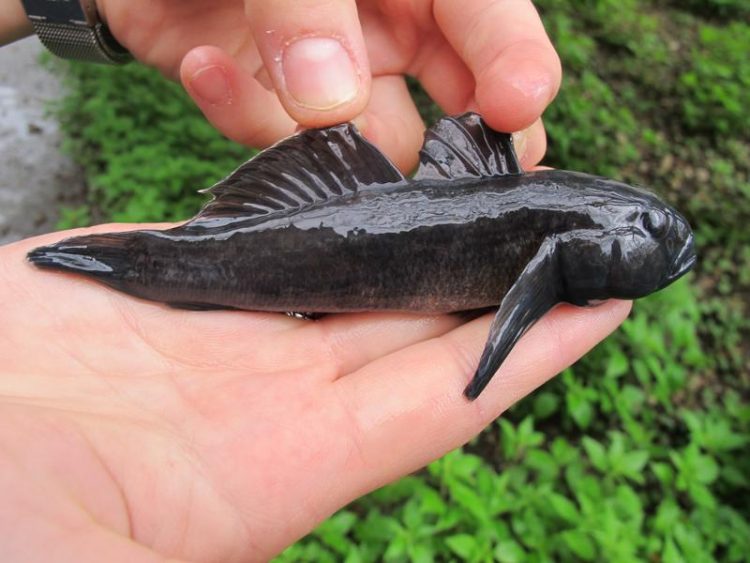New Detection Method for Goby Invasion

Ponto-Caspian goby (Neogobius melanostomus) University of Basel, Department of Environmental Sciences
Gobies from the Black and Caspian Sea are spreading along the shipping routes in Central Europe and North America. They have been present in the Swiss part of the Rhine for about four years and already dominate the bottom of the stream in the region of Basel. So far, they have not advanced further than the water power plant in Rheinfelden, but a continuing expansion seems inevitable.
Current methods of fish monitoring are not suited to adequately measure the spreading of Ponto-Caspian gobies as they are labor-intensive and not sufficiently sensitive. Accordingly, infestations of an area with gobies are often only discovered when they have reached high densities and efforts of containment remain futile. Researchers of the Department of Environmental Sciences of the University of Basel have now developed a test that allows for the detection of Ponto-Caspian gobies in streaming and stagnant water.
Measuring the environmental DNA
With a commercially available, though slightly modified, water column sampler, water samples are taken from the bottom of the water body, where invasive gobies live. Via feces or scales, the fish release so-called environmental DNA into the stream. The water samples are then analyzed for traces of this so-called eDNA in the lab. The test developed at the University of Basel reacts exclusively to the genetic material of Ponto-Caspian gobies, but not to domestic fish species.
The procedure is less time and cost-intensive than angling, and the samples can even be drawn by untrained individuals. Unlike electrofishing, the method does not impact the fish fauna and can consequently be used in protected zones and breeding grounds.
First test for lotic water
Five species of invasive gobies populate wide areas of freshwater and brackish waters in Central Europe – the species that is most common to the region around Basel, Neogobius melanostomus, even figures among the 100 worst invaders in Europe.
“Our test is one of the first approaches that targets a specific fish species and detects it successfully in flowing freshwater” says the study’s lead author, Dr. Irene Adrian-Kalchhauser. “We hope that our work contributes to establishing eDNA as a standard method in European water resource management. Similar tests have been used for a few years to track the expansion of the Asian carp in the United States.”
Original article
Irene Adrian-Kalchhauser, Patricia Burkhardt-Holm
An eDNA assay to monitor a globally invasive fish species from flowing freshwater
PLOS ONE 11 (1) | doi: 10.1371/journal.pone.0147558
Further Information
Dr. Irene Adrian-Kalchhauser, University of Basel, Department of Environmental Sciences, Tel. +41 61 26704 10, email: irene.adrian-kalchhauser@unibas.ch.
https://www.unibas.ch/en/News-Events/News/Uni-Research/New-Detection-Method-for-…
Media Contact
All latest news from the category: Life Sciences and Chemistry
Articles and reports from the Life Sciences and chemistry area deal with applied and basic research into modern biology, chemistry and human medicine.
Valuable information can be found on a range of life sciences fields including bacteriology, biochemistry, bionics, bioinformatics, biophysics, biotechnology, genetics, geobotany, human biology, marine biology, microbiology, molecular biology, cellular biology, zoology, bioinorganic chemistry, microchemistry and environmental chemistry.
Newest articles

Superradiant atoms could push the boundaries of how precisely time can be measured
Superradiant atoms can help us measure time more precisely than ever. In a new study, researchers from the University of Copenhagen present a new method for measuring the time interval,…

Ion thermoelectric conversion devices for near room temperature
The electrode sheet of the thermoelectric device consists of ionic hydrogel, which is sandwiched between the electrodes to form, and the Prussian blue on the electrode undergoes a redox reaction…

Zap Energy achieves 37-million-degree temperatures in a compact device
New publication reports record electron temperatures for a small-scale, sheared-flow-stabilized Z-pinch fusion device. In the nine decades since humans first produced fusion reactions, only a few fusion technologies have demonstrated…





















